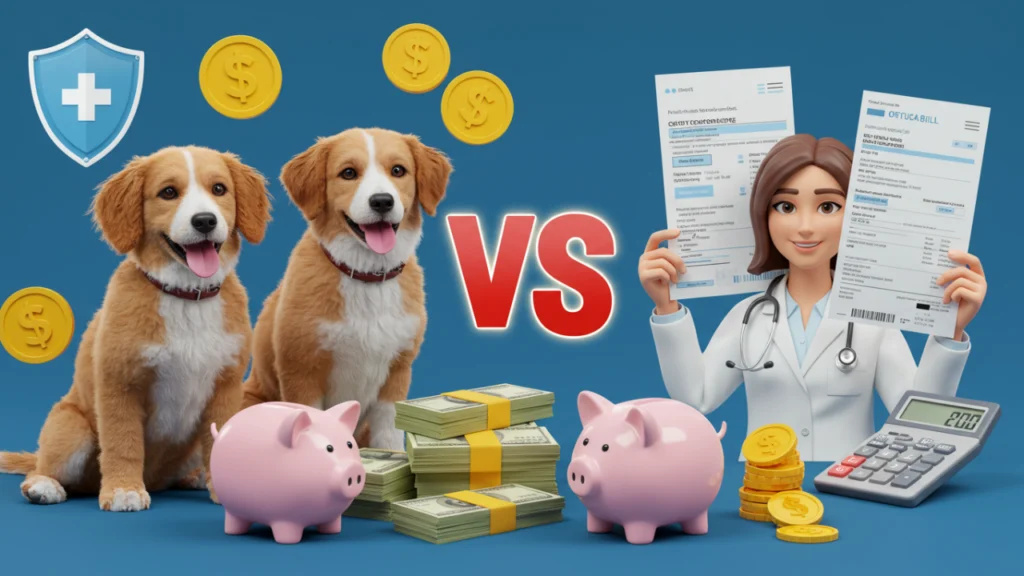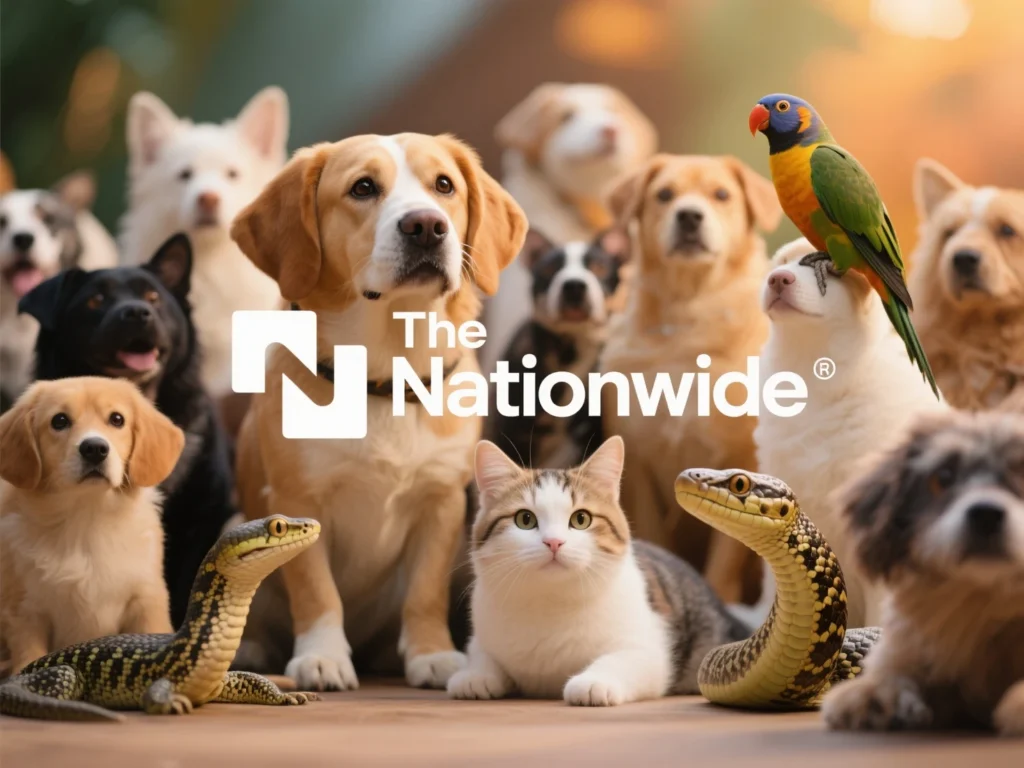Pet Insurance Cost Comparison Hacks are key to helping you save money while ensuring your fur friend gets the best care possible. In this article, you’ll discover what pet insurance is, how it works, and the important terms you need to know. You’ll see why comparing costs matters and gain tips to find the best deals.
We’ll explore what types of coverage you need and how to evaluate your options wisely. Plus, you’ll learn how to balance routine care with emergencies. With real-life examples, making the right choice for your pet has never been simpler!
Key Insights
- Understand how pet insurance works to save money on vet bills.
- Compare costs of insurance vs. paying out-of-pocket.
- Long-term care may cost less with insurance for chronic issues.
- Emergencies can be costly—insurance helps cover big bills.
- Check different providers for the best pricing and coverage options.

Summary
Understanding Pet Insurance Basics
What is Pet Insurance?
Pet insurance is a way to help cover the costs of your furry friend’s medical care. Think of it like health insurance for people. When your pet gets sick or has an accident, the insurance can help pay for the vet bills. This means you won’t have to dig too deep into your pockets when your pet needs help.
How Does Pet Insurance Work?
Pet insurance works by having you pay a monthly premium. In return, the insurance company agrees to pay part of your pet’s medical expenses. When you visit a vet, you pay for the services upfront, then file a claim with your insurance. Depending on your plan, the insurance may reimburse you for a percentage of the costs.
Key Terms You Should Know
- Premium: The amount you pay every month for your insurance.
- Deductible: The amount you must pay out of pocket before the insurance kicks in.
- Reimbursement: The money you get back from the insurance company after filing a claim.
- Coverage Limit: The maximum amount the insurance will pay for your pet’s care in a year.
The Importance of Cost Comparison
Why Compare Pet Insurance Costs?
When choosing pet insurance, comparing costs is crucial. Different companies offer various plans at different prices. By comparing these costs, you can find a plan that fits your budget while still providing good coverage for your pet.
Long-Term Savings with Cost Comparison
Over time, the right pet insurance can save you a lot of money. For example, if your pet develops a chronic illness, the costs can add up quickly. Having insurance can lighten that financial burden. For more insights on managing costs, consider exploring cost-saving tips for mobile pet services.
How to Analyze Your Pet’s Needs
To find the best insurance, start by thinking about your pet’s health. Consider factors like age, breed, and any existing health issues. This will help you choose a plan that offers the right coverage for your pet’s unique needs.
Pet Insurance Cost Comparison Hacks
Tips to Find the Best Deals
- Shop Around: Don’t settle for the first quote you get. Check multiple providers.
- Look for Discounts: Some companies offer discounts for multiple pets or annual payments.
- Read Reviews: See what other pet owners say about their experiences with different insurers. For detailed reviews, check out Nationwide pet insurance reviews.
How to Use Online Tools for Quotes
Many websites allow you to compare pet insurance quotes easily. You can enter your pet’s information and get quotes from several companies in one place. This can save you a lot of time and help you make an informed decision.
Comparing Multiple Providers Easily
When you have quotes from different providers, create a simple table to compare them. Here’s a sample layout:
| Provider | Monthly Premium | Deductible | Coverage Limit | Reimbursement Percentage |
|---|---|---|---|---|
| Provider A | $30 | $200 | $5,000 | 80% |
| Provider B | $25 | $300 | $4,000 | 90% |
| Provider C | $35 | $150 | $6,000 | 70% |
This table allows you to see at a glance which provider offers the best value for your needs.
Evaluating Policy Options
Types of Pet Insurance Policies
There are a few different types of pet insurance policies. Here are the main ones:
- Accident-Only Plans: Covers injuries from accidents but not illnesses.
- Illness Plans: Covers illnesses but not accidents.
- Comprehensive Plans: Covers both accidents and illnesses.
What to Look for in a Policy
When evaluating policies, consider the following:
- Coverage: Make sure the policy covers what you need.
- Exclusions: Check what is not covered.
- Waiting Periods: Some policies have waiting periods before coverage begins.
Essential Coverage for Your Pet
It’s crucial to have coverage that matches your pet’s needs. For example, if your dog is prone to hip dysplasia, ensure that your policy covers that condition. For more guidance on dog health insurance, visit dog health insurance insights.

Premium Discounts and Savings
How to Get Discounts on Pet Insurance
Many pet insurance companies offer discounts. Here are ways to save:
- Multi-Pet Discounts: Insure more than one pet to get a lower rate.
- Annual Payments: Pay your premium annually instead of monthly for savings.
- Referral Discounts: Some companies give discounts for referring friends.
Bundling Insurance for Extra Savings
If you have other types of insurance, like home or auto, consider bundling them with your pet insurance. Many companies offer discounts when you bundle policies, which can lead to significant savings. For more on insurance bundling, see pricing for various pet services.
Special Offers to Watch For
Keep an eye out for seasonal promotions or limited-time offers. Many companies provide discounts during the holidays or pet adoption month.
Coverage Analysis for Chronic Illnesses
The Cost of Chronic Conditions
Chronic illnesses can be expensive to manage. For instance, if your pet develops diabetes, you may face ongoing costs for insulin, vet visits, and monitoring. Pet insurance can help cover these costs, making it easier for you to provide the necessary care.
How Insurance Helps with Long-Term Care
With the right insurance, you won’t have to worry as much about the costs of long-term care. This can give you peace of mind, knowing that your pet will receive the treatment they need without breaking the bank.
Real-Life Examples of Coverage Needs
Consider a scenario where a 7-year-old cat develops kidney disease. Without insurance, you might pay thousands for treatment. However, with a comprehensive plan, you could save a significant amount, as the insurance would cover a large portion of the expenses.
Emergency Care and Insurance
The High Cost of Pet Emergencies
Pet emergencies can happen at any time and often come with hefty price tags. For instance, an emergency surgery can cost anywhere from $1,500 to $5,000. Without insurance, you might have to make tough choices about your pet’s care.
How Insurance Can Save You Money
Having pet insurance can make emergencies less stressful. You’ll be more likely to seek immediate care, knowing that your insurance can help cover the costs. This can ultimately save your pet’s life.
Key Factors in Emergency Coverage
When looking at emergency coverage, consider these factors:
- Coverage Limits: Ensure the plan covers enough for emergency situations.
- Exclusions: Check if any emergencies are excluded from coverage.
- Reimbursement Rates: Look for plans that offer high reimbursement percentages for emergencies.
Routine Care and Pet Health Insurance
Importance of Regular Check-Ups
Regular vet visits are essential for your pet’s health. Routine care can catch issues early, saving you money in the long run. Pet insurance can help cover the costs of these check-ups. For insights on vet check-up costs, refer to vet check-up pricing.
How Insurance Covers Preventive Care
Some pet insurance plans offer coverage for preventive care, such as vaccinations and annual exams. This can help you keep your pet healthy without worrying about the costs.
Balancing Routine Care Costs with Insurance
When choosing a plan, think about how much routine care your pet needs. If your pet requires frequent vet visits, look for a plan that includes preventive care coverage.
Making the Right Choice for Your Pet
Factors to Consider When Choosing Insurance
When selecting pet insurance, consider the following:
- Your Pet’s Age and Health: Older pets may need more coverage.
- Your Budget: Find a plan that fits your financial situation.
- Coverage Needs: Make sure the plan covers what’s important for your pet.
How to Decide Between Insurance and Out-of-Pocket
Deciding whether to go for insurance or pay out-of-pocket can be tough. Consider your pet’s health history and potential future needs. If your pet is likely to require extensive care, insurance may be the better option.
Tips for Making an Informed Decision
- Do Your Research: Look into different providers and plans.
- Ask for Recommendations: Talk to other pet owners about their experiences.
- Consult Your Vet: Your veterinarian can provide insights into what coverage might be best for your pet.
Conclusion
In conclusion, understanding pet insurance and its costs can be a game changer for you and your furry friend.
By comparing costs and knowing the ins and outs of different policies, you can make an informed decision that not only fits your budget but also ensures your pet receives the best possible care. Remember, the right insurance plan can save you money in the long run, especially when it comes to emergency situations and chronic illnesses.
So, take the time to shop around, read reviews, and consider your pet’s unique needs. It’s not just about saving a few bucks; it’s about providing peace of mind and ensuring your beloved companion gets the treatment they deserve. Don’t wait until it’s too late—start your journey towards smarter pet insurance choices today!
For more insightful articles and tips on pet care and insurance, be sure to explore more at Tech Havela. Your pet’s health is worth it!
Frequently Asked Questions
What are Pet Insurance Cost Comparison Hacks?
You can find smart ways to compare pet insurance costs. It can help you choose the best plan for your furry friend.
Is pet insurance cheaper than paying out-of-pocket?
It often is! Paying upfront for services can add up fast. Insurance can save you money in the long run.
How do I know if I need pet insurance?
If your pet has health issues, it’s a good idea. Insurance can help with big bills that come from chronic illnesses or emergencies.
Can I save money with pet insurance for routine care?
Yes! Check plans that cover routine care. It can save you money on vaccinations and check-ups.
How can I compare pet insurance providers?
Look for online comparison tools. They can give you side-by-side cost comparisons and benefits.
What factors affect pet insurance costs?
Your pet’s age, breed, and health can change prices. Older pets may cost more to insure.
Are there waiting periods with pet insurance?
Most plans have waiting periods before coverage starts. Be sure to check these details before you sign up.
**Sidnir Vieira**
Founder of TechHavela
A passionate pet and tech content creator, helping dog owners across the U.S. make smarter decisions for their furry friends.



